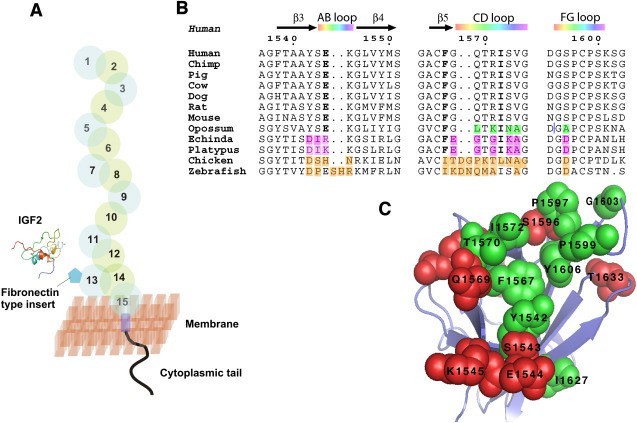What is IGF2R Protein
The Insulin-like Growth Factor 2 Receptor (IGF2R) is a multifunctional protein that plays a crucial role in the growth and development of an organism. Found in all mammalian cells, this protein is a part of the large family of receptor proteins known for its essential role in various metabolic processes.
The IGF2R protein was discovered as part of the cell machinery required for regulating specific processes within cells. This receptor protein came into the scientific fore in the late twentieth century when researchers started elucidating the underlying molecular mechanisms regulating cellular functions and behaviours.
The IGF2R gene that encodes the IGF2R protein is located on the long( q) arm of chromosome 6 at locus 23.2-23.3. Structurally, the IGF2R protein is a type of transmembrane protein, bridging the inside and outside of a cell. The protein can be roughly divided into three parts, including a large extracellular domain, a single helical transmembrane domain, and a relatively small intracellular domain. The extracellular domain of the protein acts as the binding site for the insulin-like growth factor and the intracellular domain catalyzes signals inside the cell.
Function of IGF2R protein
IGF2R protein performs the decisive task of binding with Insulin-like Growth Factor 2 (IGF-2), a hormone regulating growth during embryonic development and, to a lesser extent, postnatal growth. This interaction between IGF-2 and IGF2R essentially leads to the degradation of IGF-2, thereby limiting its availability for binding with other receptors that promote cellular growth. By controlling IGF-2 availability, IGF2R plays a crucial role in suppressing tumorigenesis and in maintaining tissue homeostasis.

Fig1. IGF2 Binding Pocket of IGF2R Domain 11 and Its Evolution (Christopher Williams, et al. 2007)
IGF2R protein related signal pathway
IGF2R is a part of a complex signalling pathway that regulates cellular growth and development. The binding of the insulin-like growth factor (IGF) ligands to their respective receptors triggers a cascade of intracellular events that ultimately impact cellular behaviors like growth, differentiation, migration, survival, and metabolism. In addition to regulating IGF-2, the IGF2R protein is also known to interact with a multitude of other proteins and ligands, thereby making the IGF signalling pathway a complex network of interactions.
IGF2R protein related diseases
A mutation or altered expression of the IGF2R gene can lead to numerous diseases. For instance, research shows that it plays a significant role in cancer development. Specific mutations in this gene might contribute to increased cell growth and resistance to apoptosis, which is one of the hallmarks of cancer. Furthermore, the IGF2R gene is also associated with longevity and population aging, with certain variations being linked to extended lifespan in humans.
Apart from cancer, mutations or dysregulation in the IGF2R gene have also been implicated in a variety of other diseases including heart disease, diabetes, and obesity, highlighting the broad physiological relevance of this protein.
IGF2R protein's applications in biomedical
Given its essential role in growth regulation and disease, the IGF2R protein has been heavily studied for therapeutic applications. The protein could potentially serve as a target for cancer therapy, mainly because of its function as a tumor suppressor. Strategies to increase the activity of the IGF2R protein could potentially inhibit cancerous cell growth. Similarly, considering its role in diabetes, developing drugs to tweak the activity of the IGF2R receptor might offer novel therapeutic approaches.
In sum, the IGF2R protein, with its pivotal role in cellular growth and development and implications in a plethora of diseases, presents a vital area of study in biomedical research, with significant therapeutic potential. Ongoing research keeps unveiling new dimensions about this intriguing protein, thereby fortifying its position as a key player in biomedical science. Understanding just exactly how the IGF2R protein functions at the molecular level may just be the key to unlocking new strategies to combat a variety of diseases.
Our Featured Products
| Cat.No. | Product Name | Species | Source (Host) | Tag |
|---|---|---|---|---|
| IGF2R-342H | Recombinant Human IGF2R protein, His-Avi-tagged, Biotinylated | Human | HEK293 | His-Avi |
| GF2R-625H | Active Recombinant Human IGF2R, Fc-tagged, Biotinylated | Human | Human Cell | Fc |
| IGF2R-677H | Active Recombinant Human IGF2R, His-tagged | Human | CHO | HIS |
| IGF2R-3081H | Recombinant Human IGF2R protein, GST-tagged | Human | E.coli | GST |
| Igf2r-849M | Recombinant Mouse Igf2r protein, His-tagged | Mouse | E.coli | His |
| GF2R-4465M | Recombinant Mouse IGF2R Protein, His (Fc)-Avi-tagged | Mouse | HEK293 | His (Fc)-Avi |
| Igf2r-1729R | Recombinant Rat Igf2r protein, His & T7-tagged | Rat | E.coli | His/T7 |
Reference
- Christopher Williams, Dellel Rezgui, Stuart N. Prince, et al. Structural Insights into the Interaction of Insulin-like Growth Factor 2 with IGF2R Domain 11. PlumX Metrics. VOLUME 15, ISSUE 9, P1065-1078, SEPTEMBER 11, 2007. DOI:https://doi.org/10.1016/j.str.2007.07.007

